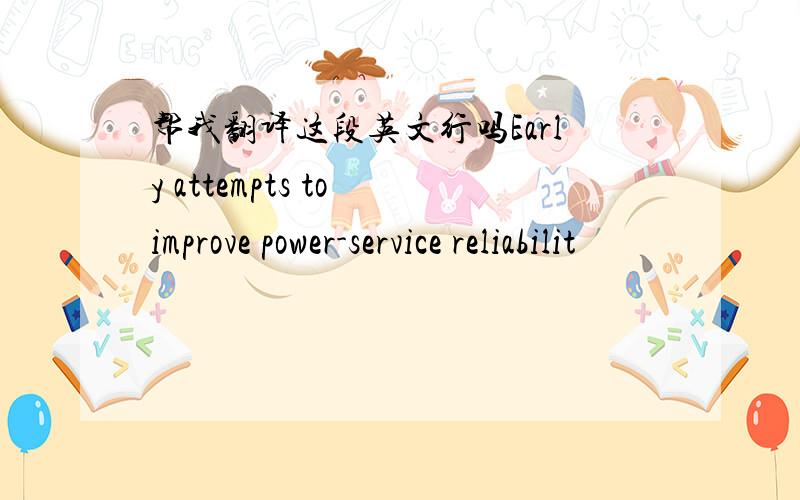帮我翻译这段英文行吗Early attempts to improve power-service reliabilit
来源:学生作业帮 编辑:大师作文网作业帮 分类:综合作业 时间:2024/11/13 00:46:10
帮我翻译这段英文行吗
Early attempts to improve power-service reliability to loads remote from generation led to the dual-line concept. Of course, it is possible to build two lines to a load, and switch the load to whichever line remains energized after a disturbance. But better service continuity will be available if both lines normally feed the load and only the faulted line is tripped when disturbances occur. Fig. 1 shows a single-generator, two-line, single-load system with breakers properly arranged to supply the load when one line is faulted. For the arrangement to be effective it is necessary to have the proper relay application. Otherwise, the expensive power equipment will not be able to perform as planned. Consider the application of instantaneous and/or time delay relays on the four breakers. Obviously the type of the relay cannot coordinate for all line faults. For example, a fault on the line terminals of breaker D. D tripping should be faster than B, however, the condition reverses and B should be faster than D. It is evident that the relay protection engineer must find some characteristic other than time delay if relay coordination is to be achieved.
Relay coordination for the system shown in Fig. 1 can now be achieved by the installation of directional overcurrent time delay relays on breakers B and D. Breakers A and C can have no directional overcurrent time delay relays. They may also now have instantaneous relays applied. The relays would be set as follows. The directional relays could be set with no intentional time delay. They will have inherent time delay. The time delay over-current relays on breakers A and C would have current settings that would permit them to supply backup protection for faults on the load bus and for load equipment faults. The instantaneous elements on breakers A and C would have current settings that would not permit them to detect faults on the load bus. Thus the lines between the generator and the load would have high-speed protection over a considerable portion of their length. It should be observed that faults on the line terminals of breakers A and C can collapse the generator voltage. The instantaneous relays on breakers A or C cannot clear the circuit instantaneously, because it takes time for power equipment to operate. During this period there will be little or no current flow through breakers B and D. Therefore, B or D cannot operate for this fault condition until the appropriate breaker at the generating station has operated. This is known as sequential tripping. Usually, it is acceptable under such conditions.
谢谢了
Early attempts to improve power-service reliability to loads remote from generation led to the dual-line concept. Of course, it is possible to build two lines to a load, and switch the load to whichever line remains energized after a disturbance. But better service continuity will be available if both lines normally feed the load and only the faulted line is tripped when disturbances occur. Fig. 1 shows a single-generator, two-line, single-load system with breakers properly arranged to supply the load when one line is faulted. For the arrangement to be effective it is necessary to have the proper relay application. Otherwise, the expensive power equipment will not be able to perform as planned. Consider the application of instantaneous and/or time delay relays on the four breakers. Obviously the type of the relay cannot coordinate for all line faults. For example, a fault on the line terminals of breaker D. D tripping should be faster than B, however, the condition reverses and B should be faster than D. It is evident that the relay protection engineer must find some characteristic other than time delay if relay coordination is to be achieved.
Relay coordination for the system shown in Fig. 1 can now be achieved by the installation of directional overcurrent time delay relays on breakers B and D. Breakers A and C can have no directional overcurrent time delay relays. They may also now have instantaneous relays applied. The relays would be set as follows. The directional relays could be set with no intentional time delay. They will have inherent time delay. The time delay over-current relays on breakers A and C would have current settings that would permit them to supply backup protection for faults on the load bus and for load equipment faults. The instantaneous elements on breakers A and C would have current settings that would not permit them to detect faults on the load bus. Thus the lines between the generator and the load would have high-speed protection over a considerable portion of their length. It should be observed that faults on the line terminals of breakers A and C can collapse the generator voltage. The instantaneous relays on breakers A or C cannot clear the circuit instantaneously, because it takes time for power equipment to operate. During this period there will be little or no current flow through breakers B and D. Therefore, B or D cannot operate for this fault condition until the appropriate breaker at the generating station has operated. This is known as sequential tripping. Usually, it is acceptable under such conditions.
谢谢了

第一段翻译
早期种种尝试是改善电源(电压供电)服务负载可靠性,经过漫长的几代演变成两线制概念.当然,是完全成立:可以建立两线制的负载; 这样的话,可以切换负载至两线中任意一线,其中一线受到干扰后另一线仍正常运作.但是更好的连续性服务也有新的可行性:如果 故障发生时,出错的1线跳闸.两个线路负载仍然正常运作.图 1 就显示单个发电机 两线制 单负载系统,当断路器被妥善安排以供应负载,一条线损坏或错误发生,此项安排是有效的,但必须正确应用继电器.否则昂贵的电力设备将无法按计划执行.考虑到瞬时和/或时间延迟继电器的应用在四个断路器上,很显然的这个类型继电器不能协调所有线路故障.例如,出现了故障:一个断路器D线路的接线端子跳闸,D应该比B跳闸快,然而,相反的来说,推论应该是B比D跳闸快,显然,继电保护工程师必须找到某些特征否则如果单凭继电器的协调来实现的话,必将出现时间延迟.
第二段翻译
继电保护系统如图1 所示,现在断路器B和D上可以安装定向的电流过载时间延迟继电器来实现目的,断路器A和C也可以不安装这个继电器.不安装时A,C也同时有(断路器B,D)继电器安装以后的效果.继电器应如下所示安装:定向继电器应设定成无内置时间延迟状态.但是本身将固有时间延迟(无可避免).如果断路器A和C上安装了时间延迟电流过载继电器并有电流设置的话,将允许断路器A,C 提供 负载总线故障和负载设备故障 备份保护.如果在断路器A和C上的瞬时(反映)元件上有电流设置,这就不允许A,C 检测总线故障.因此发电机和负载之间的线路很大部分长度用于过速保护.应当指出,断路器A或C上的接线端子上的故障甚至能损坏发电机电压.断路器A或C上的瞬时继电器不能马上清除线路(中的故障),因为它需要花费时间去运行电力设备.在此期间,将有不多的或根本没有 电流通过断路器B和D.因此B或D不能解决此故障状态,直到发电机中适当断路器运行后才可以(解决).这就是所谓的序贯/连续跳闸. 通常情况下,是可以接受的.
早期种种尝试是改善电源(电压供电)服务负载可靠性,经过漫长的几代演变成两线制概念.当然,是完全成立:可以建立两线制的负载; 这样的话,可以切换负载至两线中任意一线,其中一线受到干扰后另一线仍正常运作.但是更好的连续性服务也有新的可行性:如果 故障发生时,出错的1线跳闸.两个线路负载仍然正常运作.图 1 就显示单个发电机 两线制 单负载系统,当断路器被妥善安排以供应负载,一条线损坏或错误发生,此项安排是有效的,但必须正确应用继电器.否则昂贵的电力设备将无法按计划执行.考虑到瞬时和/或时间延迟继电器的应用在四个断路器上,很显然的这个类型继电器不能协调所有线路故障.例如,出现了故障:一个断路器D线路的接线端子跳闸,D应该比B跳闸快,然而,相反的来说,推论应该是B比D跳闸快,显然,继电保护工程师必须找到某些特征否则如果单凭继电器的协调来实现的话,必将出现时间延迟.
第二段翻译
继电保护系统如图1 所示,现在断路器B和D上可以安装定向的电流过载时间延迟继电器来实现目的,断路器A和C也可以不安装这个继电器.不安装时A,C也同时有(断路器B,D)继电器安装以后的效果.继电器应如下所示安装:定向继电器应设定成无内置时间延迟状态.但是本身将固有时间延迟(无可避免).如果断路器A和C上安装了时间延迟电流过载继电器并有电流设置的话,将允许断路器A,C 提供 负载总线故障和负载设备故障 备份保护.如果在断路器A和C上的瞬时(反映)元件上有电流设置,这就不允许A,C 检测总线故障.因此发电机和负载之间的线路很大部分长度用于过速保护.应当指出,断路器A或C上的接线端子上的故障甚至能损坏发电机电压.断路器A或C上的瞬时继电器不能马上清除线路(中的故障),因为它需要花费时间去运行电力设备.在此期间,将有不多的或根本没有 电流通过断路器B和D.因此B或D不能解决此故障状态,直到发电机中适当断路器运行后才可以(解决).这就是所谓的序贯/连续跳闸. 通常情况下,是可以接受的.